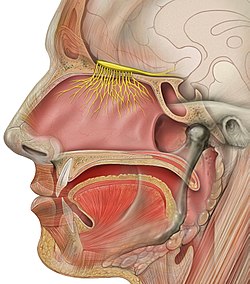Structure and Function of the Olfactory Nerve
- The olfactory nerve is the first cranial nerve.
- It contains sensory nerve fibers related to the sense of smell.
- The olfactory nerve originates in the olfactory mucosa in the nasal cavity.
- It travels through the cribriform plate of the ethmoid bone to reach the brain.
- The olfactory nerve is not visible on a cadaver brain.
- The olfactory nerve transmits sensory stimuli in the form of odorants.
- It encodes odorants into electrical signals.
- The olfactory nerve relays olfactory information to higher-order centers in the brain.
- It works to ensure the identification and distinction of various odorants.
- Odorants interact with olfactory receptor neurons to initiate olfaction.
Odor Transduction
- Odorants bind to specific odorant receptor proteins on olfactory cilia.
- This binding evokes an electrical response in olfactory receptor neurons.
- Olfactory receptor molecules consist of trans-membrane domains and a cytoplasmic domain.
- Activation of adenylate cyclase leads to an increase in cyclic AMP.
- Depolarization of the neuron occurs through ion channels and generates an action potential.
Regeneration of Olfactory Nerves
- Olfactory receptor neurons can be damaged by inhaled substances.
- The olfactory epithelium consists of supporting cells, mature ORNs, and basal cells.
- Basal cells divide to produce new receptor neurons for regeneration.
- ORNs undergo a cycle of degeneration and regeneration.
- The regeneration process is unique to ORNs.
ORN Specificity
- Odorant molecules interact with receptor proteins on localised neuronal cilia.
- Each olfactory receptor neuron expresses one type of protein receptor.
- Mature ORNs have decreased expression levels of multiple olfactory receptor genes.
- Different odors activate specific ORNs in a molecular and spatial manner.
- ORNs can have high affinity and selectivity for specific odorants.
Additional Information and References
- Additional images: Olfactory nerve, deep dissection, inferior view.
- Related topics: Wikimedia Commons has media related to Nervus olfactorius, anterior olfactory nucleus, phantosmia.
- References: Various sources including textbooks and scientific articles on anatomy, physiology, and neuroscience.
The olfactory nerve, also known as the first cranial nerve, cranial nerve I, or simply CN I, is a cranial nerve that contains sensory nerve fibers relating to the sense of smell.
| Olfactory nerve | |
|---|---|
 The olfactory nerve | |
| Details | |
| Innervates | Smell |
| Identifiers | |
| Latin | nervus olfactorius |
| MeSH | D009832 |
| NeuroNames | 32 |
| TA98 | A14.2.01.004 A14.2.01.005 |
| TA2 | 6181 |
| FMA | 46787 |
| Anatomical terms of neuroanatomy | |
The afferent nerve fibers of the olfactory receptor neurons transmit nerve impulses about odors to the central nervous system (olfaction). Derived from the embryonic nasal placode, the olfactory nerve is somewhat unusual among cranial nerves because it is capable of some regeneration if damaged. The olfactory nerve is sensory in nature and originates on the olfactory mucosa in the upper part of the nasal cavity. From the olfactory mucosa, the nerve (actually many small nerve fascicles) travels up through the cribriform plate of the ethmoid bone to reach the surface of the brain. Here the fascicles enter the olfactory bulb and synapse there; from the bulbs (one on each side) the olfactory information is transmitted into the brain via the olfactory tract. The fascicles of the olfactory nerve are not visible on a cadaver brain because they are severed upon removal.
olfactory nerve (plural olfactory nerves)